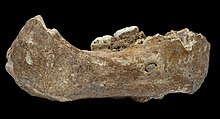Baishiya Karst Cave
白石崖溶洞 | |
 | |
| Location | Xiahe County, Gansu, China |
|---|---|
| Region | Ganjia Basin, Tibetan Plateau |
| Coordinates | 35°26′53″N 102°34′17″E / 35.44806°N 102.57139°E |
| Altitude | 3,280 m (10,761 ft)[1] |
| Type | karst cave |
| Length | > 1 km (3,281 ft) |
| Width | 20 m (66 ft) |
| Height | 10 m (33 ft) |
| Site notes | |
| Excavation dates | 2018 |
| Archaeologists | Zhang Dongju, Chen Fahu |
Baishiya Karst Cave (
Geography
Baishiya Karst Cave is located in Ganjia (甘加镇), Xiahe County, Gannan Tibetan Autonomous Prefecture, Gansu, China, on the northeastern edge of the Tibetan Plateau.[2] It lies on the southern side of Dalijiashan Mountain,[1] at the foot of a white cliff.[3] The cave is situated in the Ganjia Basin, at the mouth of the Jiangla River, a tributary of the Yangqu River.[1] The cave is over 1 km (3,281 ft) in length.[1] Within 80 metres (260 ft) from the entrance, the cave's winter daytime temperature is normally 8–9 °C (46–48 °F), suitable for habitation in the harsh winters of the Tibetan Plateau.[4]
Religion
Baishiya Karst Cave is a
Fossils

In 1980, a
In 2020 Denisovan DNA plus stone artefacts and animal bones were recovered from the Buddhist holy cave on the Tibetam Plateau by scientists from the University of Wollongong, Australia including Professor Bo Li. Denisovan DNA was recovered from four layers in the cave dated between 45.000 and 100,000 years ago. A fragment of jawbone had been found in the cave in 2019. Aboriginal Australians have about 5% of Denisovan DNA.[7]
The Xiahe mandible consists of the right half of a partial mandible with two attached
References
Citations
- ^ a b c d e f g Chen et al. 2019.
- ^ a b c d GNRTV 2016.
- ^ a b c d Hublin 2019.
- ^ a b c Wu 2019.
- ^ a b Gibbons 2019.
- ^ a b Max-Planck-Gesellschaft 2019.
- ^ "In a Tibetan cave archaeologists find evidence of a mysterious ancestor". Stuff/Fairfax. 4 November 2020.
- ^ a b Warren 2019.
- Discover Magazine. Retrieved 2020-02-25.
- ^ "Top 10 stories of 2019: A black hole picture, measles outbreaks, climate protests and more". Science News. 2019-12-16. Retrieved 2020-02-25.
- ^ "The top 10 science stories of 2019". www.pbs.org. Retrieved 2020-02-25.
Bibliography
- Chen, Fahu; Welker, Frido; Shen, Chuan-Chou; Bailey, Shara E.; Bergmann, Inga; Davis, Simon; Xia, Huan; Wang, Hui; Fischer, Roman; Freidline, Sarah E.; Yu, Tsai-Luen; Skinner, Matthew M.; Stelzer, Stefanie; Dong, Guangrong; Fu, Qiaomei; Dong, Guanghui; Wang, Jian; Zhang, Dongju; Hublin, Jean-Jacques (2019-05-01). "A late Middle Pleistocene Denisovan mandible from the Tibetan Plateau" (PDF). S2CID 141503768.
- Gibbons, Anne (2019-05-01). "First fossil jaw of Denisovans finally puts a face on elusive human relatives". Science; AAAS. Retrieved 2019-05-01.
- "那些不能错过的甘南美景之白石崖溶洞" (in Chinese). Gannan Radio and Television. 2016-12-20. Archived from the original on 2019-05-04. Retrieved 2019-05-02.
- Hublin, Jean-Jacques (2019-05-01). "How We Found an Elusive Hominin in China". SAPIENS. Retrieved 2019-05-02.
- "First hominins on the Tibetan Plateau were Denisovans". Max-Planck-Gesellschaft. 2019-04-11. Retrieved 2019-05-01.
- Warren, Matthew (2019-05-01). "Biggest Denisovan fossil yet spills ancient human's secrets". Nature. 569 (7754): 16–17. S2CID 141503756.
- Wu, Bin (2019-05-02). "这块骨头来自一个神秘人种,证明16万年前古人类已登上青藏高原". Sohu (in Chinese). Retrieved 2019-05-02.



